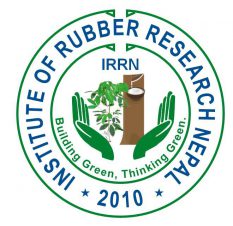TILAK BHANDARI
Natural rubber is one of the most important raw materials that is important for transportation, industry, defense and medical field in the world. It is used for manufacture of more than 40,000 products including 400 medical devices. It is largely produced from Hevea brasiliensis plantation is South Asia. It is a high value and green material crop for the current era. The world’s rubber needs stand at around 21 million tones per year each supply roughly 50 % of the market.
Based on twenty years research study of Gorakhkali Rubber Industry Ltd. with the joint venture, Sudha Falrus Pvt. Ltd, Jhapa set up 1990 Pioneer Pilot Project, 18 years of yield performance Hevea cultivation is highly potential in Eastern Terai districts of Jhapa, Morang, Sunsari and lower parts of Ilam. Observation from these Pioneer plantation and very encouraging results are now covering only 150 ha in different locations like Budhabare, Dhaijan, Surunga, Prithinagar of Jhapa, Average yield is 1796 kg per hectare, 80 percent of holding by small farmers. Present natural rubber price is $3.50/kg in the international market.
In Nepal, the consumption of natural rubber has been increasing consistently during the last many years. The production so far is 20 ton per year while consumption is 12,000 metric tons (US $ 30 million per year). It has been estimated that by 2020 AD, the demand of natural rubber is expected to cross 20,000 metric ton per year. The Eastern Terai stretching from North to South several districts indiscriminate degrading (Governments and people) of the natural forest cover and the cultivation practiced by the people has completely denuded vast tracts of land.
 We are encouraged by the expansion of rubber cultivation more or less under similar condition in Eastern and North – Eastern States of India. Eastern parts of Terai region could be safely and confidently categorized as suitable for commercial scale. From a preliminary and detailed study, it can be concluded that 15,000 to 20,000 hectares of land in the districts of Jhapa, Morang, Sunsary and low elevation of Ilam (< 450 Meter) could be brought under rubber cultivation which could meet the requirement of natural rubber. Well maintained plantation would yield an average of 2,000 kg of dry rubber per hectare per year. This is equivalent to present price of 5 lakh/ha./year. Economically, production period is 26 years starting from 7th years of planting. Cost of production of rubber could be relatively low in view of the good availability of land, infra-structure facilities, reasonable cost of labors etc. Ministry of Agriculture and cooperatives (Rubber Board, Nepal) should offer free advisory research, training and extension services at all stages from suitable credit, site selection, nursery establishment, bee-keeping to crop processing, grading, packing, market access, rubber goods manufacturing technology.
We are encouraged by the expansion of rubber cultivation more or less under similar condition in Eastern and North – Eastern States of India. Eastern parts of Terai region could be safely and confidently categorized as suitable for commercial scale. From a preliminary and detailed study, it can be concluded that 15,000 to 20,000 hectares of land in the districts of Jhapa, Morang, Sunsary and low elevation of Ilam (< 450 Meter) could be brought under rubber cultivation which could meet the requirement of natural rubber. Well maintained plantation would yield an average of 2,000 kg of dry rubber per hectare per year. This is equivalent to present price of 5 lakh/ha./year. Economically, production period is 26 years starting from 7th years of planting. Cost of production of rubber could be relatively low in view of the good availability of land, infra-structure facilities, reasonable cost of labors etc. Ministry of Agriculture and cooperatives (Rubber Board, Nepal) should offer free advisory research, training and extension services at all stages from suitable credit, site selection, nursery establishment, bee-keeping to crop processing, grading, packing, market access, rubber goods manufacturing technology.
Various elements are necessary for the success of small and large holder rubber plantation on a country. Small-holders plantation provide more flexibility and seen more competitive and industrial plantation today. Supporting the organization of planters and producers in cooperatives and their involvement in initial process.
Bonus payment
Therefore, scientists also recommends other ways of money making from plantation (man made forest) provide timber, rubber seed, oil cake, honey, orchid. The average timber yield from hectare of rubber plantation at the end of the 33 years economic life is 250 cubic meters (30 lakh Rs-equivalent to $40,000). Furthermore, natural rubber help prevent weather related disasters happening in all parts of the global. Natural rubber is a very environmentally friendly tree. It will help us to have interrupted weather, which is good for entire agriculture sector and country.
There are also carbon trading and carbon offset markets. Both are open to investors. It is estimated that the amount of GHG (Green House Gases) offsetting that 10 fast growing rubber trees can provide is equal to the yearly footprint (10 ton carbon) of an average person living in USA and Europe. 500 plant in a hectare mean 500 ton of carbon.
That is $12500 (NRs 9,00,000) direct benefit for rubber growers. One ton of carbon is trading at around US $ 25-30. The rubber tree absorbs and fixes atmospheric carbon. This is a well recognized service to the environment. So rubber plantation can easily trade in carbon markets.
World scenario
Natural rubber is a main raw material for vehicle tires. 73% of natural rubber produced in the world goes to manufactures tires related products and vehicle components. In 2009, vehicles sales have reduced in the USA and EU but steady increases in Asia, particularly in China and India. Vehicles sales in China increased around 2 million and India sold around one million new vehicles and South America, is estimated to need about 5 million new vehicles per year. Natural rubber has to supply this demand.
The International Rubber Study Group (IRSG) says there will be no decline in natural rubber prices until 2020. Rubber experts will recommend rubber as the top plantation investment of the future. Without delay Nepal Government need implement a massive action plan with the helps of World Bank, USAID, Wal-Mart Foundation or other possible donors for commercial rubber plantation in Nepal. Natural rubber is crop of economically top, socially beneficial and environmentally highly acceptable.

